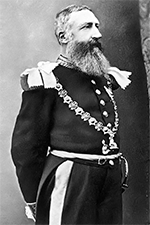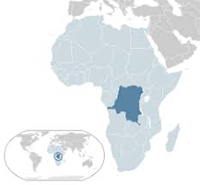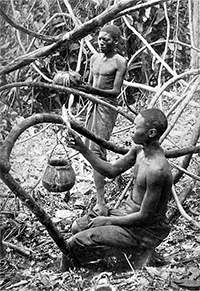The Congo Free State
The Congo Free State was an autocratic state, made up of what is now the Democratic Republic of the Congo, that existed for nearly three decades in the second half of the 19th Century. The sole owner and ruler was King Leopold II of Belgium. 
What is now Belgium was for most of history part of the Low Countries and then the Netherlands. In 1830, the Belgian Revolution created the new, modern country. The first ruler of Belgium was King Leopold I, father of Leopold II (left). The first Leopold died in 1865, and his son took over the throne. Both Leopolds wanted for their country a prominent role in world politics. They refused to get involved in wars and other political struggles, professing a neutrality that other countries respected. Both monarchs also wanted their country to have a worldwide reach. Son moreso than father concentrated on establishing Belgian colonies in areas other than Europe. Leopold II became fixated on the Philippines, but those overtures resulted in nothing concrete. Asian and Pacific lands, nations, and territories had long been targets for European powers. With the advent of international trade in the late Middle Ages came European penetration into Africa, to support routes for transporting goods, currency, and people. As the 19th Century progressed, the powers of Europe focused more and more on Africa as a means of establishing colonies and otherwise enhance their reputations and bottom lines. Leopold invited dozens of famous explorers and entrepreneurs to the Brussels Geographic Conference in 1876. The kind made it known that he wanted to promote humanitarian enterprises in Africa, tapping in to a longheld European belief that it was the right and responsibility of people in Europe to bring civilization to the world, particularly to Africa. One result of that geographic conference was the creation of the International African Association, designed to promote those goals. 
Leopold II also enlisted the efforts and expertise of famous U.K. explorer Henry Stanley, who was exploring central Africa even as the Belgian king was drumming up support for such efforts. At Leopold's direction, Stanley oversaw in the Congo the construction of a major road and an expansion of riverborne trade, making treaties with local leaders as necessary. As well, Stanley set up military posts to safeguard these new enterprises. Back in Europe, Leopold was hard at work convincing other European leaders to sanction his takeover of the Congo. His efforts culminated in the unanimous approval of all in attendance at 1884 Berlin Conference for the establishment of a huge Belgian presence in central Africa. Leopold's name for the new political entity was the Congo Free State. Leopold was the sole ruler of the state, which had 14 administrative districts and a capital, Boma. He was the sole owner of the business that was the state. He appointed advisers to help run things, but he made all important decisions. And because he was the only owner of what was, in effect, a money-making enterprise, he realized all profits. Belgian interests clashed with those of the United Kingdom in southern Africa. U.K. forces solidified their hold on South Africa and then, after the turn of the century, annexed and then held, after a pair of wars, territories once held by the Boers. Before that, though, Leopold and the U.K. found common ground in the east, exchanging land rights that saw the Congo Free State gain access to the Lado Enclave, a strip of land that allowed Congalese merchants access to lucrative traffic along the Nile River. 
As envisioned originally, the Congo Free State was a vehicle for Belgium's elevating their status in the ivory trade. The target soon was rubber, as the demand for the commodity skyrocketed as the century was coming to a close. Leopold, as owner and ruler, set production targets that were unrealistically high; failure to meet those targets resulted in swift and brutal retribution. Methods used including beatings, torture, and even amputation. Enforcing all of that were members of Leopold's private army, the Force Publique, who reported solely to him. The numbers of Europeans, Belgian or otherwise, in the Congo Free State at any one time was statistically insignificant compared to the number of Africans, yet it was the Belgians who held all of the power, forcing the Congalese people to toil in harsh conditions for little to no reward, sacrificing their freedom, parts of their bodies, and even their lives if they deviated from the path set out for them. The death toll, from a variety of sources, was very high. The major cause of death was the enforced labor system and its consequences for insufficient production; however, many people during that time died from disease, who spread rampantly in the poor sanitary conditions endured by workers. Consevrative estimates put the number of Congalese dead during this period at 1 million; some historians estimate that deaths numbered more than 10 million. Rubber was in very high demand around the world at the end of the 19th Century and the beginning of the 20th Century. Profits for the Congo Free State in 1903 reached an all-time high. However, with such profits came scrutiny. As much as Leopold wanted to keep his work enforcement methods a secret, word of the inhumane conditions endured by workers leaked out. Eyewitness accounts of atrocities proliferated, and criticism from within and without mounted. The author Joseph Conrad served as a steamer captain on the Congo River for a dozen years and based his novel Heart of Darkness in part on some of what he witnessed. So, too, the journalist Edmund Dene Morel investigated conditions in the Congo Free State and reported on them in his magazine, The West African Mail. The U.K. government sent noted diplomat Roger Casement to Boma, capital of the Congo Free State, to investigate; his report on what he found helped spark a re-examination of matters by other European powers. Some governmental leaders in Belgium found out from other world powers what their own king hadn't told them. Finally bowing to international pressure, Leopold handed over the reins of the Congo Free State to his own country, at a hefty price. Belgium assumed control on Nov. 15, 1908, and renamed it Belgian Congo and relaxed the production pressures that had resulted in to much suffering. Leopold died the very next year. |
|
Social Studies for Kids
copyright 2002–2025
David White




